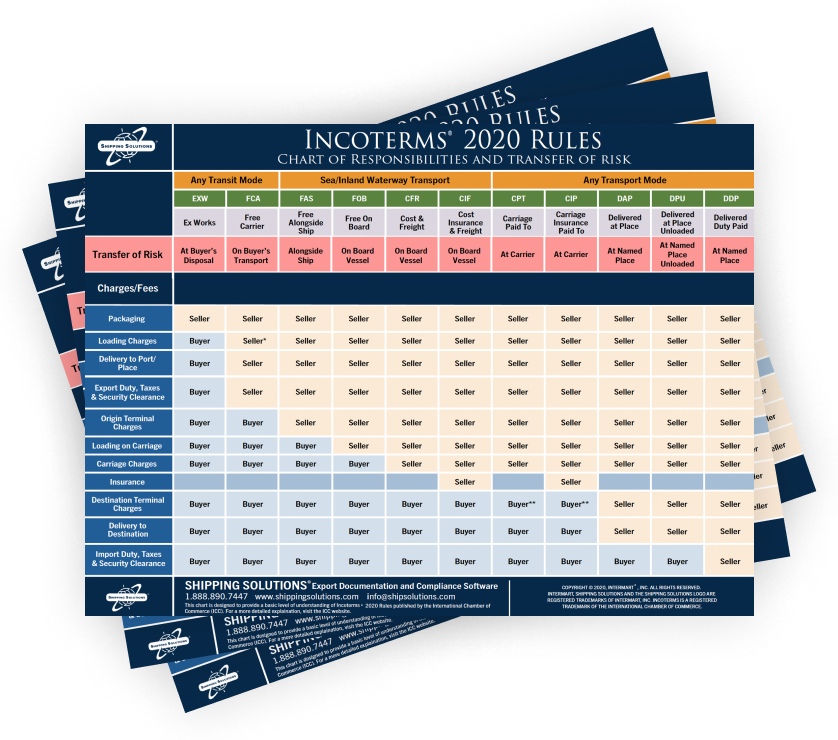The International Trade Blog Export Forms
Understanding Your Ocean Freight Invoice
On: February 8, 2023 | By:  Sean Whitworth |
6 min. read
Sean Whitworth |
6 min. read
 It’s a challenge to make sure you are getting fair ocean rates for your shipments in a sea of different providers. It also takes a figurative army of people to move your international freight from one country to another. Charges can come from the ocean carrier, the customs authorities, the port operators, truckers, container depots, warehouses and more. Your freight forwarder will conveniently aggregate these charges as they accrue to your invoice. One confounder is also the term of sale—or Incoterm—used, which can cause charges to vary.
It’s a challenge to make sure you are getting fair ocean rates for your shipments in a sea of different providers. It also takes a figurative army of people to move your international freight from one country to another. Charges can come from the ocean carrier, the customs authorities, the port operators, truckers, container depots, warehouses and more. Your freight forwarder will conveniently aggregate these charges as they accrue to your invoice. One confounder is also the term of sale—or Incoterm—used, which can cause charges to vary.
Here's a guide to the line items you will likely see on your ocean freight invoice and an explanation for each one.
The Goods Start Their Journey (Pre-Carriage)
For the sake of clarity, let’s assume a full container (FCL) shipment using the Incoterm EX Works (EXW), where you are the importer of goods. EXW indicates that you (the importer) are responsible for all charges, starting with the loading of the goods from the shipper’s dock to unloading at the receiver’s door. Your charges can change based on your origin and destination points as well, because different countries have different regulations, fees and customs formalities. Here’s the breakdown of some charges you are likely to see.
Pickup Charge/Drayage/Inland Transport
These are simply the fees the trucker is going to charge for using their services. This means picking up the goods and moving them to the terminal at the ocean port. Drayage typically means a short inland move by truck. The distance is usually less than 100 miles, but there is no official mileage limit to what constitutes a drayage move. However, if your goods are more distant from the origin port, they could be moved to the terminal by rail, or a non-drayage carrier.
Fuel Surcharge
Fuel surcharge will be assessed by the trucking company handling the inland transport. The surcharge is expressed as a percent of the linehaul rate after any discounting. This charge will vary with the cost of diesel per gallon.
Importer Security Filing (ISF)
The ISF is a United States requirement that begins the customs entry process. This must be completed 24 hours before the goods are laden on the vessel.
Export Clearance
Each country you import from will have certain requirements to move those goods out of that country as an export. This will be accompanied by a usually small fee.
Packing/Crating/Container Stuffing
The shipper may not have the ability to crate the goods, or block and brace the goods in the container to keep them stable for the perhaps tumultuous ocean voyage that is about to occur. Certain warehouses and companies specialize in crating goods and packing containers for clients who are unable to or prefer to outsource this task. Securing the cargo in the container is absolutely essential to prevent cargo damage.
Terminal Handling Charge (THC)
This is a charge to cover the operation of the terminal that is servicing your container. It pays for the labor (crane operators, stevedores, etc.) and the equipment they utilize, and for upkeep of the terminal (think cranes and forklifts).
Wharfage
A wharf is a man-made structure that the vessels use to berth. The fee is associated with the use of the wharf to unload or load the goods on the vessel. Sometimes this fee will be lumped in with the THC.
Bon Voyage (Main Carriage)
Now we get to the charges that come from the ocean carrier directly.
Ocean Freight
This is the port to port charges that are assessed by the ocean liner.
Bunker Fuel
This is the fuel charge you may see on an invoice from the ocean carrier.
Low Sulfur Fuel Charge or Surcharge
This is a fuel surcharge that arose out of an International Maritime Organization (IMO) regulation in 2012. Sulfur emissions can be hazardous to human health, and ocean carriers are required to use low sulfur fuel in certain areas. The ocean liner will charge to cover the cost of using this fuel.
Documentation Fees (Bill of Lading or BL Fee)
Fee for processing the bill of lading.
Goods Arrive (On-Carriage)
The goods have finally landed on your shores and are almost to your door. A few charges remain to get your shipment to you.
Terminal Handling Charge (THC)
Yes, that’s right; you can have two sets of handling charges on your invoice since there are multiple terminals involved in loading and unloading your freight.
Delivery Order
This fee is for the release of the goods from the ocean carrier to the nominated trucker. In an EXW scenario, the freight forwarder is handling the final trucking portion so you may or may not see this charge.
Delivery/Inland Transport
The trucks on the delivery side will need their payment as well and are going to charge for the pickup of the goods from the port.
Fuel Surcharge
Same type of charge as at origin, but since it’s based on a percent of gross linehaul trucking charges, it can be a different amount. The two prices are also bound to be different since it is two different truckers, mileages and countries.
Detention and Demurrage
Demurrage are charges assessed by the carrier for delays in getting your container and goods moved in the allotted time known as the "Last Free Day." If the container remains at the port unmoved, then the carrier will assess daily charges that must be paid before the goods will be released to your trucker. The fees can compound into the thousands of dollars, so it’s important to be aware and have partners that can make sure your goods are being moved in a timely fashion out of the port. Detention refers to keeping the container outside of the port for too long without returning the empty in a timely fashion. Ocean carriers use demurrage charges to ensure that containers are being moved out and to prevent congestion. However, during the end of 2020 and 2021, there was so much congestion in the highly trafficked Port of Los Angeles and Long Beach that demurrage charges were being used unfairly—truckers could not even get into the port due to congestion.
Customs Clearance
Fees your broker charges for clearing the goods with the customs authorities.
Customs Duties
Duties assessed based on the type of goods you imported and the regulations they're subject to. Duties are usually a percentage of the value of the goods.
Other Charges to Watch For
The above represent a high percentage of the charges you may see but certainly not all possible charges. It’s important to audit the invoices you receive and make sure you are being charged fairly. Many of these fees can be negotiated lower, so don’t be afraid to have a discussion with your forwarder, NVOCC or carrier about cost mitigation. You may also want to purchase additional freight insurance, or add guaranteed services and other accessorial charges, which can increase your costs.
For less-than-container (LCL) shipments, you will see charges for the container freight station (CFS), which breaks down the shared containers. Also keep in mind that with another Incoterm, some of these charges may be omitted. For example, with a Free On Board (FOB) Incoterm, the shipper would be responsible for the inland transport to the ocean port. Therefore you would want to make sure you don’t see a pickup charge on your bill. For more information about Incoterms, download the free eBook An Introduction to Incoterms 2020 Rules.
Like what you read? Subscribe today to the International Trade Blog to get the latest news and tips for exporters and importers delivered to your inbox.

About the Author: Sean Whitworth
Sean Whitworth is a trusted international trade expert for a number of shippers and manufacturers. He currently works in the 3PL space serving clients in a broad range of industries including energy, automotive glass and plastics, textiles, forestry products and more. He has worked as a consultant for importers/exporters assisting with everything from preparing and packaging goods for international transport, booking with freight forwarders, customs formalities and delivery of goods by land, air and sea.
Sean is currently working to develop his career further in international trade by becoming a Licensed Customs Broker.




